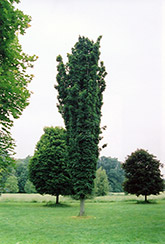Seneca Chief Sugar Maple
Acer saccharum 'Seneca Chief'
Height: 45 feet
Spread: 25 feet
Sunlight:
![]()
Hardiness Zone: 4
Other Names: Hard Maple, Rock Maple
Description:
A narrow, somewhat upright-spreading tree, quite effective for skyline articulation in the landscape; dense foliage turns a good orange and gold in fall; quite adaptable, use in smaller landscapes or as a tall screen
Ornamental Features
Seneca Chief Sugar Maple is primarily valued in the landscape for its ornamental upright and spreading habit of growth. It has rich green deciduous foliage. The lobed leaves turn outstanding shades of gold and orange in the fall.
Landscape Attributes
Seneca Chief Sugar Maple is a dense deciduous tree with an upright spreading habit of growth. Its relatively coarse texture can be used to stand it apart from other landscape plants with finer foliage.
This is a relatively low maintenance tree, and should only be pruned in summer after the leaves have fully developed, as it may 'bleed' sap if pruned in late winter or early spring. It has no significant negative characteristics.
Seneca Chief Sugar Maple is recommended for the following landscape applications;
- Vertical Accent
- Hedges/Screening
Planting & Growing
Seneca Chief Sugar Maple will grow to be about 45 feet tall at maturity, with a spread of 25 feet. It has a high canopy of foliage that sits well above the ground, and should not be planted underneath power lines. As it matures, the lower branches of this tree can be strategically removed to create a high enough canopy to support unobstructed human traffic underneath. It grows at a slow rate, and under ideal conditions can be expected to live to a ripe old age of 100 years or more; think of this as a heritage tree for future generations!
This tree should only be grown in full sunlight. It prefers to grow in average to moist conditions, and shouldn't be allowed to dry out. It is not particular as to soil pH, but grows best in rich soils. It is somewhat tolerant of urban pollution. This is a selection of a native North American species.
